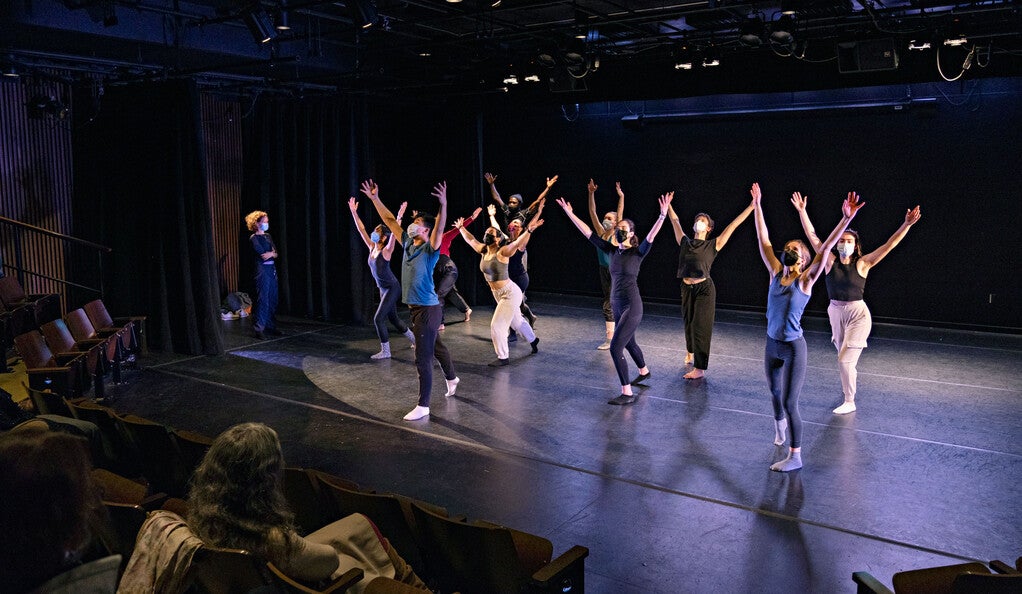As Yale Dance Lab rehearses a ballet classic, it opens doors to community

(Photo by Anna Zhang ’23)
More than a century ago, Igor Stravinsky’s ballet “Rite of Spring” created a sensation perhaps unlike any other in the history of theater. Featuring Vaslav Nijinsky’s staccato choreography and Stravinsky’s dissonant score, and depicting scenes of pagan ritual, it was unlike anything audiences had seen before. When it debuted in Paris in 1913, it famously provoked riots.
Nevertheless, it would go on to become a seminal work in the history of concert dance, heavily influencing many orchestral ballets to come.
This semester, nearly 110 years since the ballet’s debut, Yale Dance Lab began a workshop to create their own production of the classic, which will be choreographed by dancer-choreographer Emily Coates, a professor in the practice and director of dance in Theater and Performance Studies with a secondary appointment in the Directing Program at the David Geffen School of Drama at Yale, and dancer-choreographer Lacina Coulibaly, who is a lecturer in the program and an artistic associate of the Dance Lab.
On Tuesday, March 8, the Dance Lab invites members of the Yale community to watch an open rehearsal at the Crescent Theater. The presentation will be held from 4 to 6 p.m. The final performance next year will feature live music from the Yale Symphony Orchestra.
“The opportunity for such a large-scale collaboration with one of Yale's largest musical gems is very special and hopefully creates a model for more,” said Coates, who created the Yale Dance Lab in 2011.

Yale Dance Lab is a faculty-directed, co-curricular arts research initiative that aims to promote community, cross-disciplinary collaboration, and activism through dance at Yale and beyond. The initiative also provides students the chance to work with guest choreographers and industry professionals, including Yale’s own dance faculty.
Born in Burkina Faso, Coulibaly brings a unique world view and dance background grounded in African choreographic expression. His collaboration with Coates, a former New York City Ballet dancer with a background in neoclassical ballet and American postmodern dance, will allow the two artists to meld their backgrounds and differing styles together in a new, modern exploration of Nijinsky’s historic work. The production extends a collaboration they began twelve years ago when they created a duet together titled “Ici Ou Ailleurs,” which they performed widely.
“Any choreographer will find it challenging to choreograph Rite of Spring,” said Coulibaly. “It is already an emblematic piece of music and the music itself is the story.”
But despite premiering more than a century ago, its plot is still relevant today. “The storyline matches my way of seeing the world because we would rather sacrifice our lives and nature for materials, power, money, and weapons,” Coulibaly said.
The co-choreographers and their 10-dancer ensemble of Yale students began the workshop four weeks ago. And the more they work, Coates said, the more excited they become about the project’s potential.
“As you rehearse, you realize more about what it is that you are making,” she said. “It’s not just coming up with as innovative or as original or as ‘us’ of a movement as we can, it’s about working with the dancers as individuals and thinking about what it is to develop an ensemble.”
The group is also diving headfirst into the creative research process.
“We are allowing the process to unfold and see where it takes us,” Coates said. “When you develop choreography, you begin with an idea, and start to explore it. Your discoveries lead you from one place to the next until you have amassed enough movement material for a dance.”
Coulibaly added, “It really requires a lot of reflection as we transpose the whole story but keep the specificity of it as well.”
Performing in collaboration with the Yale Symphony Orchestra (YSO) next year will add to the challenge.
“Whilst the work has also become a recognized concert piece for orchestras, and something of a showpiece, a full appreciation of it can only be developed in its original carnation, with the musicians developing an understanding of the demands on dancers and therefore the tempi that are required,” said William Boughton, YSO’s musical director.
“Dancing to live music is nothing like using recorded music: the sounds are more vulnerable, human, and responsive to the movement in real time,” Coates said.
The stage production will also draw on maps and travel images from the Beinecke Rare Book & Manuscript Library’s collection to set the scene, tracing transnational networks of cultural exchange across time to meditate on planetary crises and care, Coates said. Dramaturg Faith Zamble, an M.F.A. candidate at the David Geffen School of Drama, began that research this past summer.
While the final public presentation won’t be until next year, Yale Dance Lab is eager to open its doors to the community for Tuesday’s open rehearsal.
At this rehearsal, audience members will be able to witness the process of how a dance gets made. It will also allow the audience to see how artists interchange story and challenge themselves to execute complex ideas in movement, Coulibaly said.
The dancers involved in the workshop are Laila Blavatnik ’23, Lexi Dalrymple ’25, Sophia DeVito ’23, Tadea Martin-Gonzalez ’24, Gabrielle Niederhoffer ’23, Virginia Peng ’25, Talia Rothstein, a Yale Law School student, Santana Vannarath ’24, Gabrielle Welbel ’23, and Isabella Zou ’23.
Fully vaccinated Yale faculty, students, and staff are invited to attend the open rehearsal. Read more about the event and register at this link.